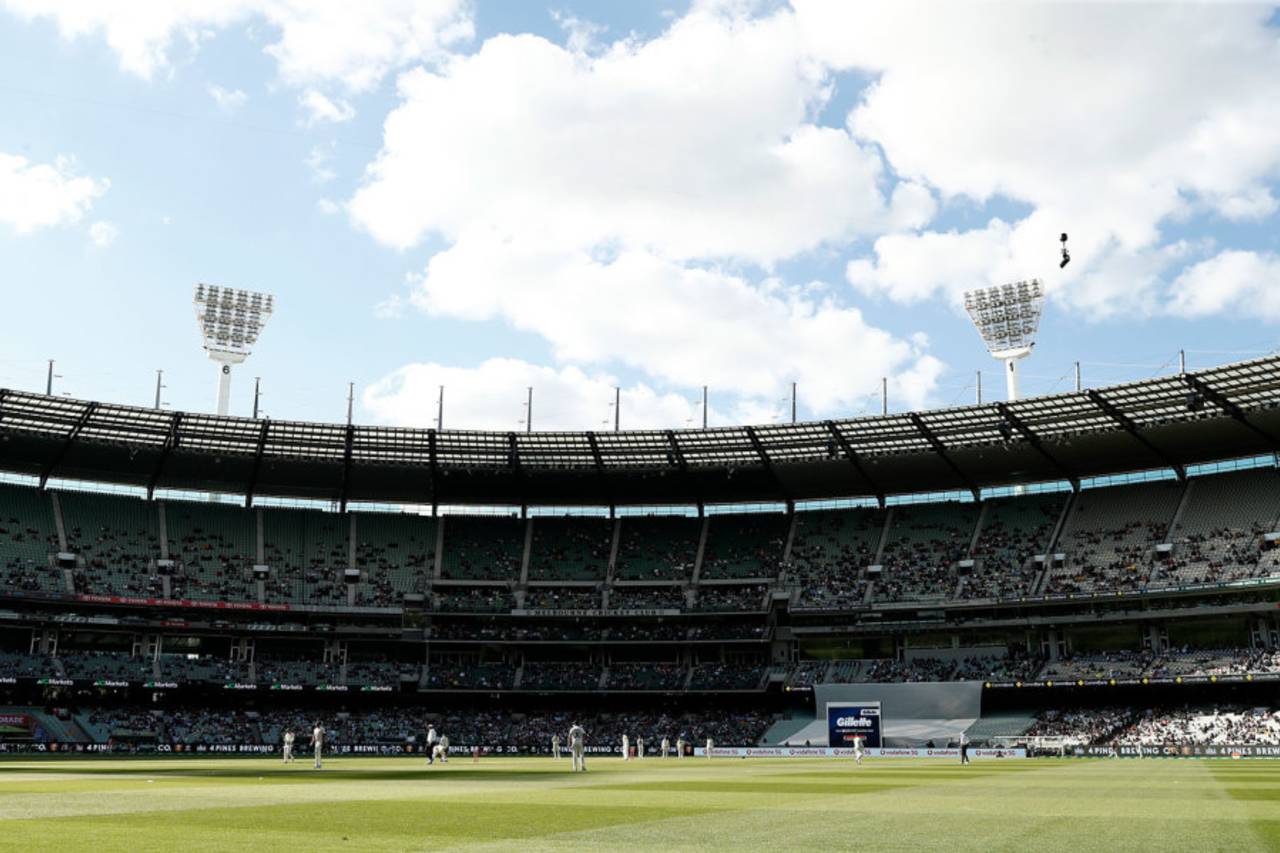On the first day of the Melbourne Test, one of the few England batting "highlights" seemed to be shots that went for three runs: 16 in all, adding up to just over 25% of the total of 185. How unusual is this high proportion? asked Charles Barr from England
I had to rope in the eminent Australian statistician Charles Davis for this one: he's spent a large proportion of his life re-scoring Test matches, from scorebooks and other sources, and now has a database covering between 80-85% of all Tests played. And so I asked - but inadvertently caused a problem down under: "This question crashed my computer, but I noticed before the screen went blank that when South Africa scored 258 for 3
at the MCG in 1993-94, they hit 30 threes, or 34.9% of the runs."
When normal service resumed next morning, Charles was able to confirm that this was the highest of 11 known instances of more than 25% of a side's total (of 100 or more) coming in threes. All of them were in Australia, with seven at the MCG, where the boundaries have always been long. He added: "When Bob Cowper scored 307 against England
at the MCG in 1965-66, his innings included 26 threes, and some of his 20 fours were all-run."
There were 14 people out caught behind - seven by each wicketkeeper - in the Centurion Test. Was this a record? asked Nikhil Tandon from India
The 14 caught-behinds in the first Test between South Africa and India
in Centurion last week stands equal 12th on
this list. It is headed by the 17 wicketkeeping dismissals in another Test in South Africa - against Pakistan
in Johannesburg in January 2019, when
Sarfaraz Ahmed made ten dismissals and
Quinton de Kock seven.
The recent Centurion Test was the ninth in which both wicketkeepers made at least seven dismissals. The first such instance was
at Lord's in 1956, when
Godfrey Evans made seven for England and
Gil Langley nine for Australia.
Denis Lindsay (who also scored 69 and 182 for South Africa) and
Brian Taber (making his debut for Australia) made eight apiece
in Johannesburg in 1966-67.
Where does Australia's 267 at Melbourne stand on the list of totals that were enough for an innings victory in a Test? asked Ken Cahill from Australia
There have been only seven lower totals that turned out to be sufficient to win a Test by an innings than Australia's 267 against England
in Melbourne last week. The lowest of all also came
at the MCG, on a sticky, rain-affected pitch in 1931-32, when Australia managed only 153, but rolled South Africa over for 36 and 45. Left-arm spinner
Bert Ironmonger - three months short of his 50th birthday - took 5 for 6 and 6 for 18.
The only lower such total in the Ashes came
at Old Trafford in 1888, when England's 172 proved enough to defeat Australia (81 and 70) by an innings and 21.
Australia were 82 ahead after the first innings at the MCG. Only two slimmer leads have resulted in innings victories, the smallest of all being England's 46-run advantage over New Zealand (246 to 200)
in Auckland in 1954-55. New Zealand then folded for 26, still the lowest total in any Test match. Then
in Kingston in 2008-09, West Indies led England by 74 (392 to 318) before skittling them for 51 to win by an innings and 23 runs.
Joe Root came close to breaking the record for Test runs in a calendar year, and was more than 1000 clear of the next Englishman. Was this a record in itself? asked Derek Chadwick from England
The short answer is yes:
Joe Root amassed 1708 Test runs in 2021, some 1178 ahead of the next England player,
Rory Burns with 530. The previous biggest discrepancy was 881 in 1976, when
Viv Richards made 1710 runs for West Indies, with
Roy Fredericks next on 829 (coincidentally, the number of runs Richards made in four Tests in England that year alone). The
only man to score more runs than Richards and Root in a calendar year is Pakistan's
Mohammad Yousuf, with 1788 in 2006.
Apparently there was an Australian player in the 1950s who went on a Test tour when his father was the manager, but I can't work out who it was! Can you help? asked Terry Matthews from Australia
The player in question was the hard-hitting Queenslander
Peter Burge. He made his Test debut against England in 1954-55, and shortly afterwards toured the West Indies in a side managed by his father, TJ "Jack" Burge. There wasn't really any conflict of interest, since Burge senior wasn't one of the tour selectors.
In Gideon Haigh's classic book The Golden Age, he recounted Peter Burge's memories of his father, who died of a heart attack early in 1957. "My dad was the best frustrated Test cricketer I ever knew. He always wanted to play, was involved in it for as long as I could remember. When I was born, my family reckoned he gave me a rattle in the shape of a bat and ball."
After struggling a little at first, by the early 1960s Peter Burge had become a dependable middle-order bulwark for Australia, finishing after the 1965-66 Ashes series with 2290 runs in 42 Tests. In later years, an expanding waistline led to the popular Burge being dubbed "the fastest-growing Sport in Queensland". It's a humorous nickname which, judging by the TV coverage of the latest Ashes series, might affectionately now be applied to
Matthew Hayden!
Shiva Jayaraman of ESPNcricinfo's stats team helped with some of the above answers

